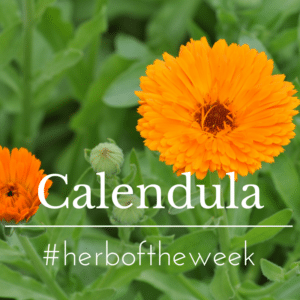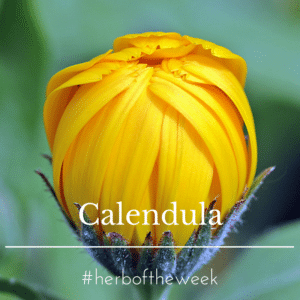Calendula: Herb of the Week

We love Calendula inside and out.
Maybe you already knew that calendula is great for cuts, abrasions, burns, and irritations on the skin – even diaper rash! But did you know it can do all that in the gut, as well? The lining of the gut is made up of the same kind of cells as skin – because it basically is skin. We think of our guts as being inside our bodies but really, the digestive tract is like the hole in a donut: it’s on the inside, but it’s still outside – it’s your “inside-outside”. Which means that you can add calendula to any of your tea formulas for irritation in the gastrointestinal tract! Ryn wrote a whole blog post about this called Gut Heal Tea, which I highly recommend.

Just a pretty flower?
That may seem strange, because Calendula is “just a pretty flower” and “don’t you need something stronger for that kind of thing?” – but I’ll tell you, I tried the somethings-stronger, and Calendula wins. I think we get these ideas that if a flower is lovely, or if it’s safe and “gentle” enough for a baby, that it is “weak” – but the gentle strength really makes it perfect for nursing thrush, because not only does it work, but you don’t have to be worried that it might harm your little one.
For thrush, I took the tincture (about a quarter ounce of tincture, three to four times a day – but dosing is different per person, so your dose may be lower than that), drank about a quart of the tea daily, soaked my nipples in very strong infusion of the flowers, and used some of that strong infusion in Amber’s mouth as well. She didn’t usually swallow it all, or even most of it, but that’s ok – I was going for the topical use, not systemic. If she had been old enough to understand mouthwash as a concept, that’s what i would have been going for.
I still turn to Calendula when I have a sinus infection, especially if the roof of my mouth gets itchy with it: as it turns out, many sinus infections are actually fungal. Others are viral, but antiviral activity has been shown too) And here it’s time for a little interlude about studies:

Synergy and constituents?
There are different types of plant “parts” – humans have different kinds of cells, like red blood cells, and immune response cells, and skin cells, whatever. The different kinds of cells do different kinds of jobs in the body. We have other kinds of molecules too – like hormones, who all have certain jobs in the body, as well. In the study of plants, we usually refer to each of these parts as “constituents” – various types of molecules that the plants create to do jobs that need doing.
One of those types or categories of molecules is called volatile oils, and these are fairly concentrated, or potent molecules, which usually have strong smells. (When you make essential oils, you are distilling out only this portion of the plant.) And in relation to Calendula, what they’ve found is that there are a whole pile of volatile oils that are extremely effective against various types of fungus. Here’s a link to a relevant study, but it’s worth noting that they were using straight essential oils, which I don’t really recommend. Regardless of the form, the chemicals involved are the same.

Why would calendula make compounds that are anti-fungal? Because plants have to fight fungus too. We can work with the parts of plants that do that job to get that work done in our own bodies, also.
For sinus infections, I use Calendula as a tincture, in fairly high doses – maybe a quarter ounce, three or four times a day (dosing varies significantly per person). I have noticed that the roof of my mouth starts to itch right before I’ll get a sinus infection, so I now take it right when that happens, and I try to hold it in my mouth for a while before swallowing it. But very importantly, I also make sure to get more rest, stop eating any sugar, not eat any bready things (even the gluten free ones). I also like to do Thyme steams as well – that way I’m getting some topical anti-microbial action directly into the respiratory tract. In this case, the Calendula is acting topically and possibly also systemicly, and the Thyme is also topical (but to different tissue). Additionally, resting and eating clean helps me to be strong enough to mount an immune response.
Tell us YOUR favorite ways to work with Calendula!
#herboftheweek
2 Comments
Leave a Comment
You must be logged in to post a comment.

Join our newsletter for more herby goodness!
Get our newsletter delivered right to your inbox. You'll be first to hear about free mini-courses, podcast episodes, and other goodies about holistic herbalism.

[…] discussed include calendula, plantain, wild lettuce, & cayenne; plus formulas including joint liniment and sprain & […]
[…] discussed include: calendula, self-heal, ground ivy, red clover, violet, chickweed, […]